Canadian economic accounts, third quarter 2012 and September 2012
Archived Content
Information identified as archived is provided for reference, research or recordkeeping purposes. It is not subject to the Government of Canada Web Standards and has not been altered or updated since it was archived. Please "contact us" to request a format other than those available.
Related subjects
-
[an error occurred while processing this directive]
Real gross domestic product (GDP) rose 0.1% in the third quarter, slowing from the 0.4% growth in the second quarter. The slower pace of growth was the result of declines in exports and business investment. Final domestic demand grew 0.4%. On a monthly basis, real GDP by industry was unchanged in September.
Exports fell 2.0% in the third quarter, the largest decline since the second quarter of 2009. Imports rose 0.4%, the fourth quarterly increase in a row. Non-farm business inventories increased $12.0 billion.
Business investment in non-residential structures and in machinery and equipment decreased 0.6%, following consecutive quarterly increases that began in the third quarter of 2009.
Residential investment declined 0.8%, as housing resale activity slowed considerably.
Household spending on goods and services advanced 0.9%, the fastest pace so far in 2012. Purchases of goods were up 0.8%, while services increased 1.1%.
Final domestic demand expanded 0.4%, following six quarters of similar gains.
Gross domestic product and final domestic demand
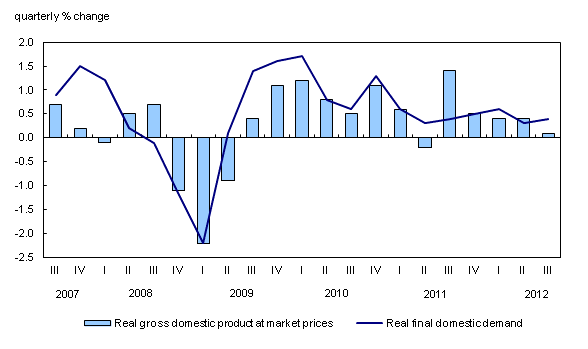
Chart description: Gross domestic product and final domestic demand
The output of service industries increased 0.4% in the third quarter, while goods production declined 0.6%. The public sector as well as the finance and insurance, utilities, transportation and retail trade sectors were the main contributors to growth in the quarter. Mining and oil and gas extraction (-2.0%) and, to a much lesser extent, manufacturing and construction were the main sources of the decline.
Oil and gas extraction fell 1.4% as both crude oil and natural gas production declined. Support activities for mining and oil and gas extraction fell 6.8%, as both drilling and rigging services declined. Mining excluding oil and gas extraction (-2.8%) was also down in the third quarter, as production declines at potash and at copper, nickel, lead and zinc mines offset increases in coal mining.
Expressed at an annualized rate, real GDP expanded 0.6% in the third quarter. By comparison, real GDP in the United States grew 2.7% in the third quarter.
Contributions to percent change in real gross domestic product, third quarter 2012
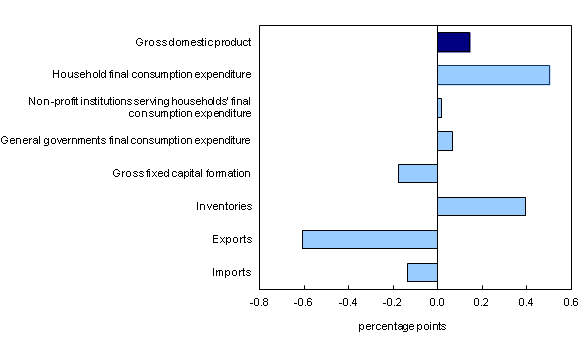
Exports fall
Exports of goods and services declined 2.0% in the third quarter. This was the largest quarterly decrease since the second quarter of 2009.
Exports of goods fell 2.1%. Energy products (-6.4%) and consumer goods (-3.7%) contributed the most to the decrease.
Exports of industrial machinery, electronic and electrical equipment, and aircraft and other transportation equipment and parts were also down. However, motor vehicles and parts (+1.1%) posted a fifth consecutive quarter of growth.
Exports of services declined 1.3%, as all categories of services fell except for travel services (+0.1%).
Exports and imports
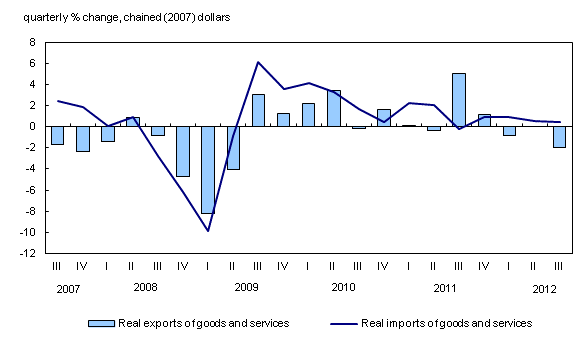
Chart description: Exports and imports
Imports increase for the fourth quarter in a row
Imports of goods and services rose 0.4% in the third quarter, as imports of services (+1.6%) outpaced goods imports (+0.2%). Imports recorded a fourth quarterly increase in a row.
Imports of basic and industrial chemical, plastic and rubber products (+4.7%) recovered in the third quarter, contributing the most to the increase in goods imports. Metal and non-metallic minerals products (+2.7%), and energy products (+1.4%) were also significant contributors to the increase.
Most of the other major categories of imports declined. Imports of aircraft and other transportation equipment and parts fell 7.9%, while imports of motor vehicles and parts were down 2.0%. Imports of consumer goods also declined, led by paper and published products (-3.7%).
Among service imports, travel services grew 1.2%, a third consecutive quarterly increase. Transportation services (+3.9%) and commercial services (+0.8%) also rose after second-quarter declines.
Lower business investment in engineering structures
Business investment in non-residential structures fell 1.1% in the quarter, as investment in engineering structures declined 1.9%. Investment in non-residential buildings increased 1.3%, the fourth quarterly gain in a row.
Business investment in machinery and equipment grew 0.1%. Outlays on industrial machinery and equipment grew 1.2%, the fourth successive quarter of growth. Purchases of other electrical and electronic machinery and equipment (+3.2%) were also higher.
Nevertheless, there were widespread reductions in purchases of machinery and equipment. In particular, computers and computer equipment fell 2.1%.
Business investment in non-residential structures and in machinery and equipment
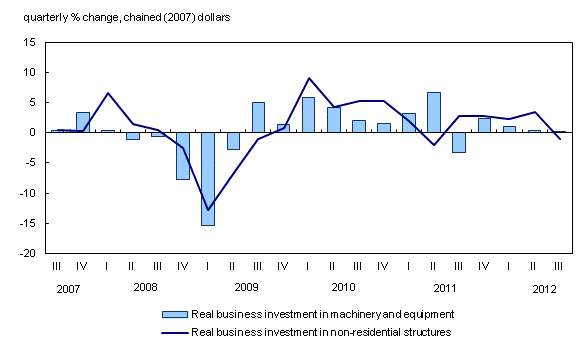
Chart description: Business investment in non-residential structures and in machinery and equipment
Demand for housing lessens
Business investment in housing fell 0.9% in the third quarter, after a 0.1% decline in the previous quarter. This decrease was the result of a 10.7% decline in ownership transfer costs as housing resale activity slowed considerably.
In contrast, renovation activity increased 0.9%, recovering from the 1.3% decline in the second quarter. New housing construction increased 1.6%, half the pace of the average 3.2% growth over the previous five quarters.
Business inventories accumulate
Non-farm business inventories rose $12.0 billion in the third quarter.
Manufacturers' inventories of durable goods increased $3.2 billion. Wholesalers accumulated $3.0 billion of durable goods in the third quarter, while retailers added $3.3 billion. There was a large increase in motor vehicle inventories.
Farm inventories also accumulated in the third quarter, especially livestock.
Consumer spending strengthens
Household spending on goods and services advanced 0.9% in the third quarter, the strongest quarterly increase since 2010. Consumers increased spending on goods by 0.8%, while services grew 1.1%.
Household spending on durable goods grew 1.4%, followed by semi-durable (+0.8%) and non-durable goods (+0.5%).
Transport purchases grew 1.2%, as vehicle purchases increased 2.3% after declining 3.3% in the previous quarter. Spending on transport services rose 1.5%.
Consumer purchases of furnishings, household equipment and other goods and services related to the dwelling and property increased 0.3%, after a decline of 0.4% in the previous quarter.
Spending on clothing and footwear increased 0.7%, after a decline of 1.1% in the previous quarter. Consumer spending on recreation and culture rose 0.6%, following two consecutive quarterly declines.
Economy-wide income expands
Nominal GDP increased 0.7% in the third quarter, over three times the pace of the previous quarter.
Compensation of employees rose 1.1%, which was less than the second-quarter pace of 1.3%. Wages in goods-producing industries advanced 1.0%, following a 1.9% increase in the second quarter. Wages in service-producing industries grew 1.2%—close to the second-quarter pace.
The net operating surplus of corporations rose 1.1% in the third quarter, following a decline of 4.4% in the second quarter. Net operating surplus of non-financial corporations increased 0.7%, while that of financial corporations increased 4.5%.
Household saving declines
Household final consumption expenditures (in current dollars) grew 1.0%, while household disposable income grew 0.8%. The household saving rate was 3.9% in the third quarter, down from 4.2% in the second quarter.
The household debt service ratio, defined as household mortgage and non-mortgage interest paid divided by disposable income, was 7.4% in the third quarter. This ratio was similar to that of the previous two quarters, but lower than the average rate of 7.6% recorded in 2011. This signifies that the servicing of household debt now requires less household disposable income than in 2011.
The national saving rate was 5.1%, compared with 5.5% in the previous quarter. National disposable income increased 0.5%, the slowest growth since the second quarter of 2009. The third-quarter slowdown was mostly the result of reduced corporate and household savings.
Improved terms of trade increase purchasing power
Canada's real gross domestic income, a measure of purchasing power, increased 0.6% in the third quarter. Canada's terms of trade, which measures export prices relative to import prices, increased 1.2%.
The price of goods and services produced in Canada rose 0.6%, after declining 0.2% in the previous quarter. Export prices fell 0.9%, while import prices declined 2.1%.
The price of final domestic demand rose 0.3%, following a 0.4% growth in the second quarter.
Gross domestic product by industry, September 2012
Real GDP was unchanged in September, after edging down 0.1% in August. Declines were recorded in wholesale trade, mining and oil and gas extraction, the arts and entertainment sector, and utilities. The declines were offset by increases in the finance, insurance and real estate sector, in the public sector, and in professional and transportation services.
Real gross domestic product unchanged in September
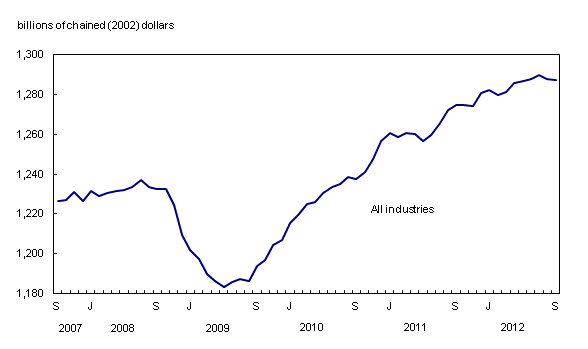
Chart description: Real gross domestic product unchanged in September
Wholesale trade fell 1.1% in September, mainly as a result of declines in the wholesaling of personal and household goods as well as motor vehicles and parts.
Mining and oil and gas extraction declined 0.4% in September. Metal ore mining decreased 3.3% as a result of declines in output at copper, nickel, lead and zinc mines as well as at gold and silver ore mines. Non-metallic mineral mining declined 2.1% as a result of decreases in output at potash mines.
Oil and gas extraction (-0.3%) decreased for a fifth consecutive month, as a decline in crude petroleum production outweighed an increase in natural gas extraction. Maintenance activities at some crude petroleum facilities affected crude oil output in September. In contrast, support activities for mining and oil extraction rose 2.5% as a result of an increase in drilling and rigging services.
Construction grew 0.1% in September. An increase in residential building construction more than offset the declines in non-residential building and engineering construction. Following four consecutive monthly declines, the output of real estate agents and brokers rose 3.7% in September, as activity in the home resale market increased.
The finance and insurance sector rose 0.2% in September on the strength of increased volume of trading on the stock exchanges. Professional services grew 0.2%, mainly as a result of increased legal services.
The public sector (education, health and public administration combined) edged up 0.1% as a result of an increase in education and health services and, to a lesser extent, public administration.
The arts and entertainment sector declined 2.6% in September, partly a result of a labour disruption that resulted in the cancellation of pre-season games in professional hockey.
Manufacturing rose 0.1% in September, as the 0.6% increase recorded by manufacturers of durable goods was partially offset by lower manufacturing of non-durable goods (-0.7%).
Main industrial sectors' contribution to the percent change in gross domestic product, September 2012
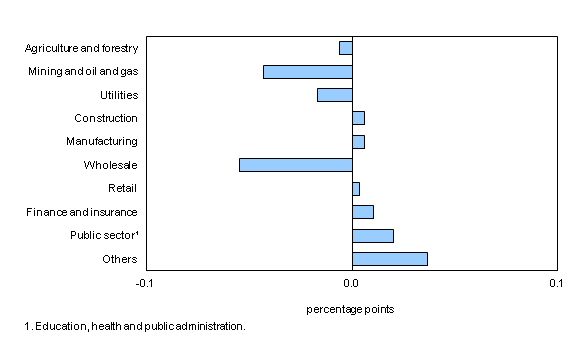
Note to readers
For more information on seasonal adjustment, see Seasonal adjustment and identifying economic trends.
Percentage changes for expenditure-based and industry-based statistics (such as personal expenditures, investment, exports, imports and output) are calculated from volume measures that are adjusted for price variations. Percentage changes for income-based and flow-of-funds statistics (such as labour income, corporate profits, mortgage borrowing and total funds raised) are calculated from nominal values; that is, they are not adjusted for price variations.
There are four ways of expressing growth rates for gross domestic product (GDP) and other time series found in this release.
1. Unless otherwise stated, the growth rates of all quarterly data in this release represent the percentage change in the series from one quarter to the next, such as from the second quarter to the third quarter of 2012.
2. Quarterly growth can be expressed at an annual rate by using a compound growth formula, similar to the way in which a monthly interest rate can be expressed at an annual rate. Expressing growth at an annual rate facilitates comparisons with official GDP statistics from the United States. Both the quarterly growth rate and the annualized quarterly growth rate should be interpreted as an indication of the latest trend in GDP.
3. The year-over-year growth rate is the percentage change in GDP from a given quarter in one year to the same quarter one year later, such as from the third quarter of 2011 to the third quarter of 2012.
4. The growth rates of all monthly data in this article represent the percentage change in the series from one month to the next, such as from August to September 2012.
With this release of monthly GDP by industry, revisions have been made back to January 2012. In the context of the comprehensive revision to the Canadian System of National Accounts, historically-revised data of monthly GDP by industry are planned for release on January 31, 2013. These revisions will extend back to January 2007 and will reflect conceptual, classification and statistical improvements. For more information about monthly GDP by industry, see the National economic accounts module on our website.
Products, services and contact information
Detailed analysis and tables
The National economic accounts module, accessible from the Key resource module of our website, features an up-to-date portrait of national and provincial economies and their structure.
Links to other releases from the national accounts can be found in the third quarter 2012 issue of Canadian Economic Accounts Quarterly Review, Vol. 11, no. 3 (Catalogue number13-010-X, free). This publication is now available from the Key resource module of our website under Publications. This publication will be updated on December 13, at the time of the release of the Financial Flow and National Balance Sheet Accounts. Revised GDP by income and by expenditure accounts for the first and second quarters of 2012 have been released, along with those for the third quarter of 2012. These data incorporate new and revised source data and updated data on seasonal patterns.
Gross domestic product by industry
Available without charge in CANSIM: table CANSIM table379-0027.
Definitions, data sources and methods: survey numbers survey number1301.
The September 2012 issue of Gross Domestic Product by Industry, Vol. 26, no. 9 (Catalogue number15-001-X, free), is now available from the Key resource module of our website under Publications.
Data on gross domestic product by industry for October will be released on December 21.
For more information, or to order data, contact us (toll-free 1-800-263-1136; infostats@statcan.gc.ca).
To enquire about the concepts, methods or data quality of this release, contact Allan Tomas (613-951-9277), Industry Accounts Division.
Gross domestic product by income and by expenditure accounts
Available without charge in CANSIM: tables CANSIM table380-0063 to 380-0076, CANSIM table380-0078 to 380-0085, CANSIM table380-0100 to 380-0106 and CANSIM table382-0006.
Definitions, data sources and methods: survey numbers survey number1901 and survey number2602.
Data on gross domestic product by income and by expenditure for the fourth quarter will be released on March 1, 2013.
For more information, consult the Guide to the Income and Expenditure Accounts (Catalogue number13-017-X, free).
To enquire about the concepts, methods or data quality of this release, contact us (toll-free 1-800-263-1136; infostats@statcan.gc.ca) or Media Relations (613-951-4636; statcan.mediahotline-ligneinfomedias.statcan@canada.ca).
- Date modified:
